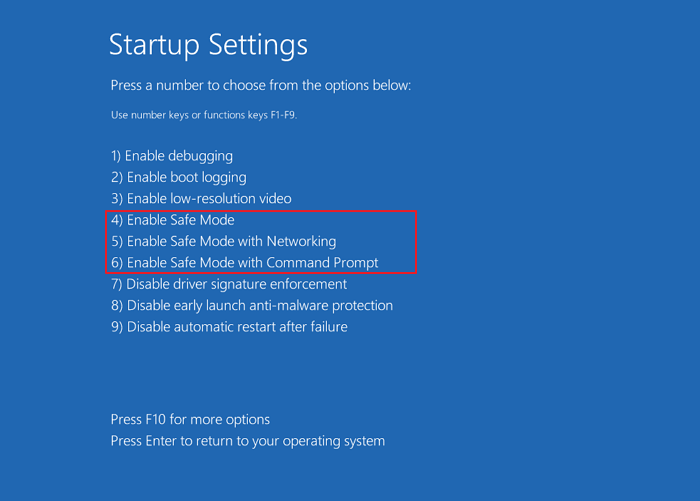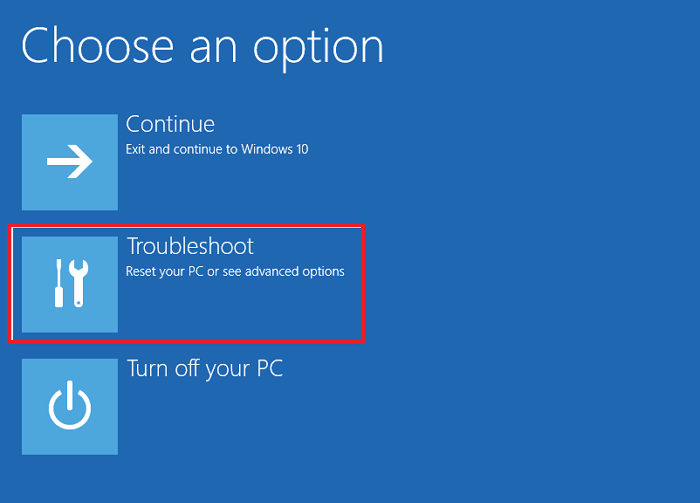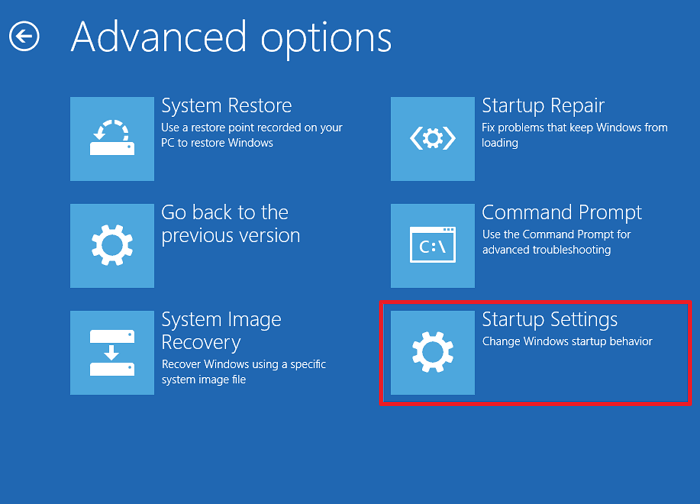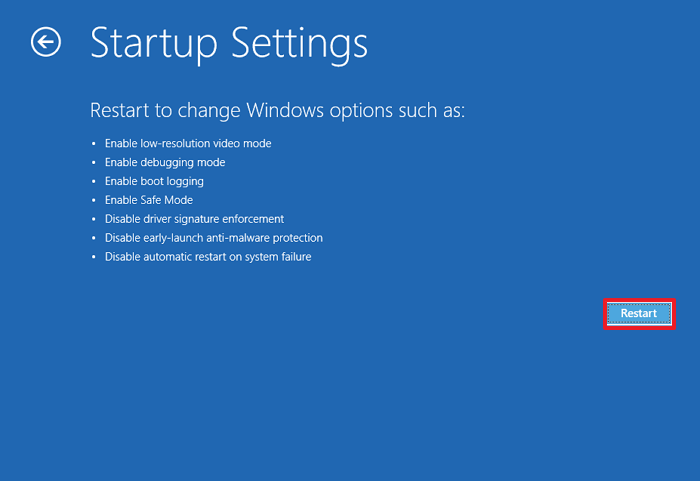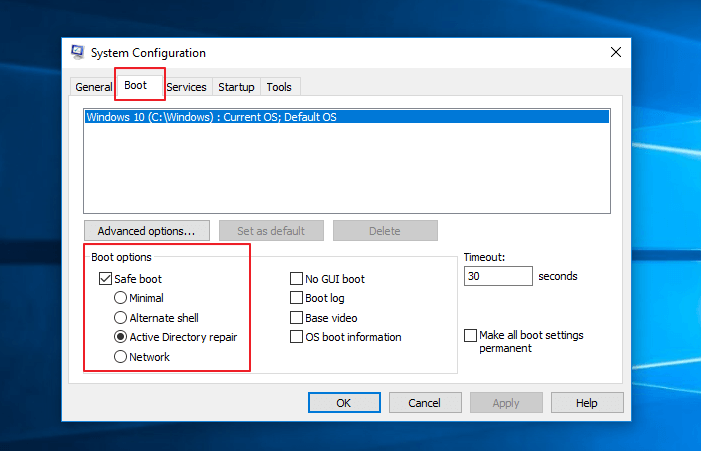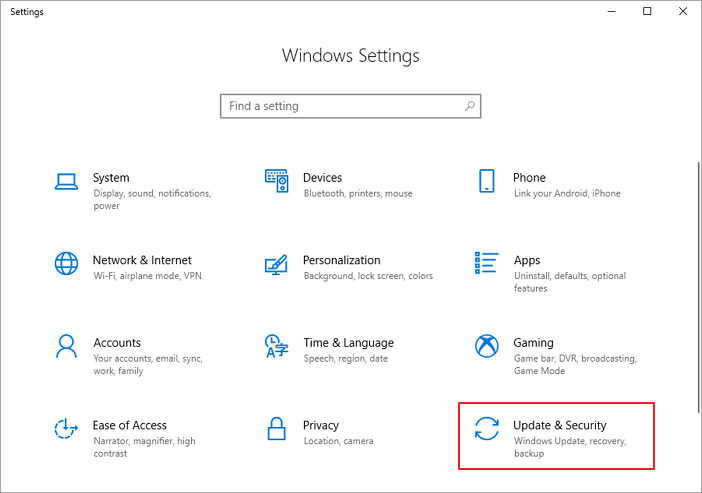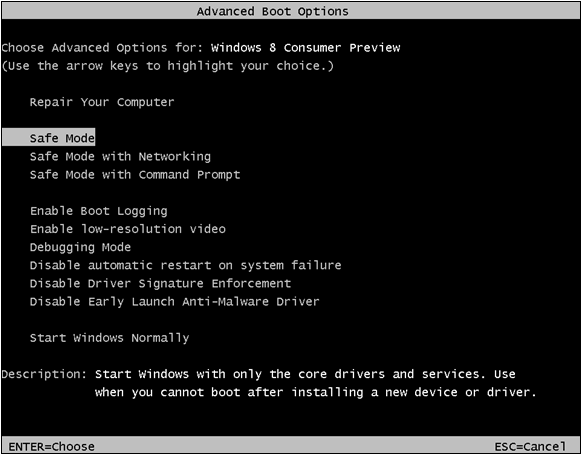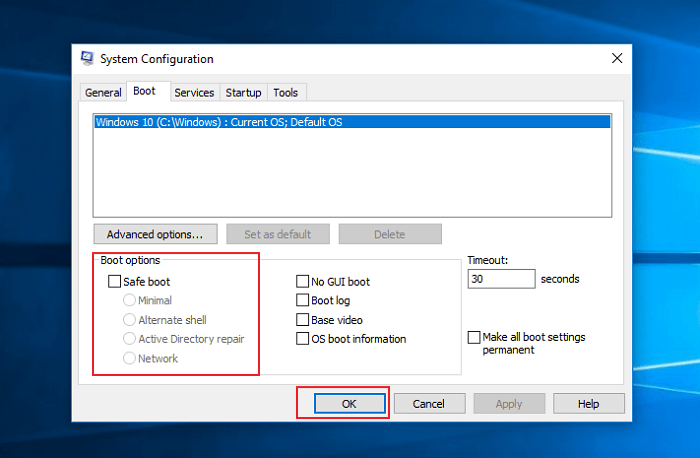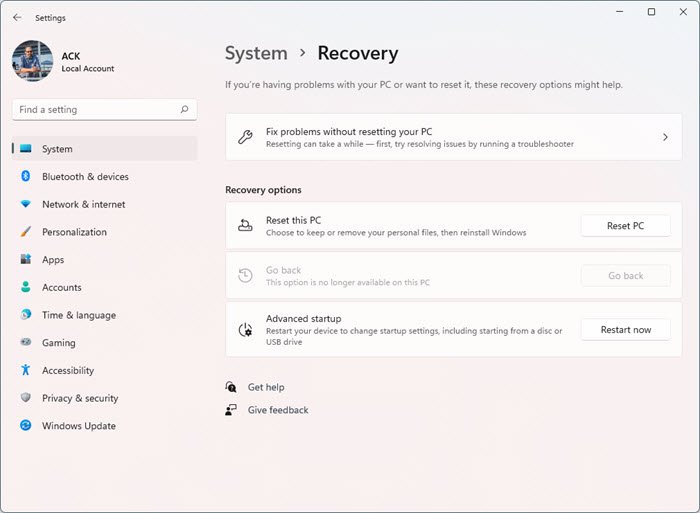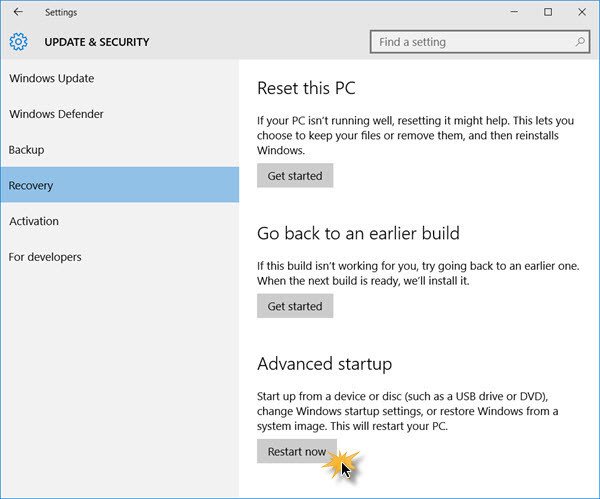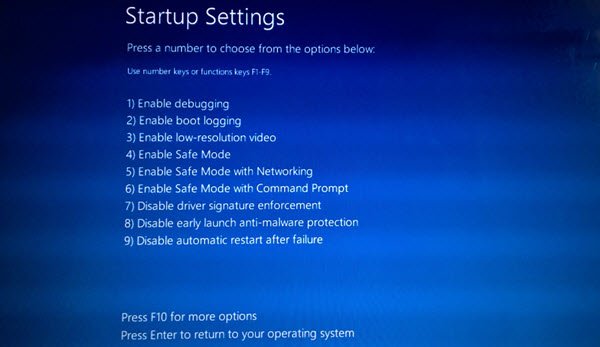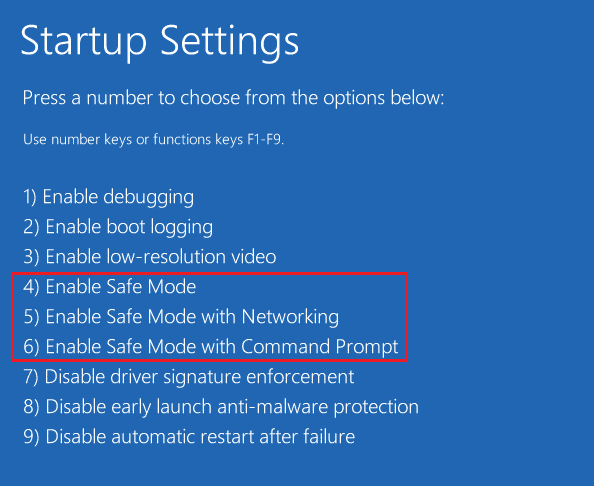Safe mode starts Windows in a basic state, using a limited set of files and drivers. If a problem doesn’t happen in safe mode, this means that default settings and basic device drivers aren’t causing the issue. Observing Windows in safe mode enables you to narrow down the source of a problem, and can help you troubleshoot problems on your PC.
There are two versions of safe mode: Safe Mode and Safe Mode with Networking. Safe Mode with Networking adds the network drivers and services you’ll need to access the internet and other computers on your network.
Select from the following sections to find out how to start your PC in safe mode from Settings, from the sign-in screen, or from a black or blank screen.
-
Press Windows logo key + I on your keyboard to open Settings. If that doesn’t work, select the Start button, then select Settings .
-
Select System > Recovery .
Open Recovery Settings -
Under Recovery options, next to Advanced startup, select Restart now.
-
After your PC restarts to the Choose an option screen, select Troubleshoot > Advanced options > Startup Settings > Restart. You may be asked to enter your BitLocker recovery key.
-
After your PC restarts, you’ll see a list of options. Select 4 or press F4 to start your PC in Safe Mode. Or if you’ll need to use the internet, select 5 or press F5 for Safe Mode with Networking.
When you can’t open Settings to get into safe mode, restart your device from the Windows sign-in screen.
-
On the Windows sign-in screen, press and hold the Shift key while you select Power > Restart .
-
After your PC restarts to the Choose an option screen, select Troubleshoot > Advanced options > Startup Settings > Restart. You may be asked to enter your BitLocker recovery key.
-
After your PC restarts, you’ll see a list of options. Select 4 or F4 to start your PC in safe mode. Or if you’ll need to use the internet, select 5 or F5 for Safe Mode with Networking.
Note: If you’ve encrypted your device, you’ll need your BitLocker key to start in safe mode.
Before you enter safe mode, you need to enter the Windows Recovery Environment (winRE). To do this, you will repeatedly turn your device off, then on:
-
Hold down the power button for 10 seconds to turn off your device.
-
Press the power button again to turn on your device.
-
On the first sign that Windows has started (for example, some devices show the manufacturer’s logo when restarting) hold down the power button for 10 seconds to turn off your device.
-
Press the power button again to turn on your device.
-
When Windows restarts, hold down the power button for 10 seconds to turn off your device.
-
Press the power button again to turn on your device.
-
Allow your device to restart into Automatic Repair, and select Advanced options to enter winRE.
Now that you are in winRE, you will follow these steps to take you to safe mode:
-
On the Choose an option screen, select Troubleshoot > Advanced options > Startup Settings > Restart.
-
After your device restarts, you’ll see a list of options. Select option 5 from the list or press F5 for Safe Mode with Networking.
If you need more info on a black or blank screen error, see Troubleshoot black screen or blank screen errors.
Notes: Restarting your device should be sufficient to exit you from Safe Mode back into normal mode. However, if for some reason your machine is still booting into Safe Mode on its own after restarting, try this:
-
Press the Windows logo key + R.
-
Type msconfig in the Open box and then select OK.
-
Select the Boot tab.
-
Under Boot options, clear the Safe bootcheckbox.
-
Press Windows logo key + I on your keyboard to open Settings. If that doesn’t work, select the Start button, then select Settings .
-
Select Update & Security > Recovery .
Open Recovery Settings -
Under Advanced startup, select Restart now.
-
After your PC restarts to the Choose an option screen, select Troubleshoot > Advanced options > Startup Settings > Restart. You may be asked to enter your BitLocker recovery key.
-
After your PC restarts, you’ll see a list of options. Select 4 or press F4 to start your PC in Safe Mode. Or if you’ll need to use the internet, select 5 or press F5 for Safe Mode with Networking.
When you can’t open Settings to get into safe mode, restart your device from the Windows sign-in screen.
-
On the Windows sign-in screen, press and hold the Shift key while you select Power > Restart .
-
After your PC restarts to the Choose an option screen, select Troubleshoot > Advanced options > Startup Settings > Restart. You may be asked to enter your BitLocker recovery key.
-
After your PC restarts, you’ll see a list of options. Select 4 or F4 to start your PC in safe mode. Or if you’ll need to use the internet, select 5 or F5 for Safe Mode with Networking.
Note: If you’ve encrypted your device, you’ll need your BitLocker key to start in safe mode.
Before you enter safe mode, you need to enter the Windows Recovery Environment (winRE). To do this, you will repeatedly turn your device off, then on:
-
Hold down the power button for 10 seconds to turn off your device.
-
Press the power button again to turn on your device.
-
On the first sign that Windows has started (for example, some devices show the manufacturer’s logo when restarting) hold down the power button for 10 seconds to turn off your device.
-
Press the power button again to turn on your device.
-
When Windows restarts, hold down the power button for 10 seconds to turn off your device.
-
Press the power button again to turn on your device.
-
Allow your device to fully restart. You will enter winRE.
Now that you are in winRE, you will follow these steps to take you to safe mode:
-
On the Choose an option screen, select Troubleshoot > Advanced options > Startup Settings > Restart.
-
After your device restarts, you’ll see a list of options. Select option 5 from the list or press F5 for Safe Mode with Networking.
If you need more info on a black or blank screen error, see Troubleshoot black or blank screen errors.
Notes: Restarting your device should be sufficient to exit you from Safe Mode back into normal mode. However, if for some reason your machine is still booting into Safe Mode on its own after restarting, try this:
-
Press the Windows logo key + R.
-
Type msconfig in the Open box and then select OK.
-
Select the Boot tab.
-
Under Boot options, clear the Safe bootcheckbox.
Need more help?
Want more options?
Explore subscription benefits, browse training courses, learn how to secure your device, and more.
Communities help you ask and answer questions, give feedback, and hear from experts with rich knowledge.
Find solutions to common problems or get help from a support agent.
- Safe Mode starts your Windows 10 or 11 computer with most features disabled.
- Boot in Safe Mode when you’re troubleshooting an issue, or if Windows won’t start normally.
- To exit Safe Mode, ensure it’s disabled in the Boot Options, or just restart your computer.
Loading
Something is loading.
Thanks for signing up!
Access your favorite topics in a personalized feed while you’re on the go.
Nearly every version of Windows has a Safe Mode feature. This lets you start your computer with just the basic files and drivers it needs to run. Most extra features will be disabled, and programs will run more slowly. By default, you won’t even have internet access. But this mode lets you update your drivers safely and efficiently without encountering conflicts with third-party apps.
Safe Mode isn’t meant to be used every day. You’ll use Safe Mode when your computer isn’t working correctly — for example, when your Windows update is stuck — or when Windows won’t start up at all. By only loading the essentials, it’ll help you narrow down what’s causing the problem, which can include the system itself or something you installed.
Here’s how to boot in Safe Mode whether you have Windows 10 or Windows 11, and how to exit it when you’re done.
How to boot in Safe Mode in Windows 11
There are a couple of easy ways to start Safe Mode in Windows 11. Here are the best and most common ones:
Using the Settings app
This method requires you to be able to get to the Windows 11 desktop and start the Settings app. If you can’t get to the Settings app, see the next section instead.
1. Click the Start icon and then click Settings.
2. In the pane on the left, click System.
3. On the System page, click Recovery.
Dave Johnson/Insider
4. In the Recovery options section, to the right of Advanced startup, click Restart now.
5. When your computer restarts to the blue Choose an option screen, select Troubleshoot, then Advanced options, and then Startup Settings.
Dave Johnson/Insider
6. On the Startup Settings page, click Restart.
7. After the computer restarts again, you’ll see some options. Choose Safe Mode or, if you will need access to the internet, choose Safe Mode with Networking.
Using the Power icon
If you can’t log into the desktop to start the Settings app, you can still launch Safe Mode using the Power icon on the sign-in screen.
1. On the sign-in screen, press and hold the Shift key on your keyboard while you click the Power button and then Restart.
2. When your computer restarts to the blue Choose an option screen, select Troubleshoot, then Advanced options, and then Startup Settings.
3. On the Startup Settings page, click Restart.
4. After the computer restarts again, you’ll see some options. Choose Safe Mode or, if you will need access to the internet, choose Safe Mode with Networking.
How to exit Safe Mode in Windows 11
There are two ways you can exit Safe Mode when you are done troubleshooting your computer.
The easiest method is simply to restart your computer. To do that, click Start, then Power, then Restart. Or press and hold the Power button on your PC.
Dave Johnson/Insider
If you’ve restarted your computer but it remains in Safe Mode, do this:
1. Press the Windows key + R to open the Run window.
2. In the text box, type msconfig and press Enter.
3. At the top of the System Configuration window, click the Boot tab.
4. Underneath Boot options, make sure that Safe boot is unchecked. Then click OK and restart your computer again.
Dave Johnson/Insider
How to boot in Safe Mode in Windows 10
There are many ways to enter Safe Mode in Windows 10 as well. Here are the three easiest:
Using the Power icon
If you’re signed in:
1. Click the Windows icon in the bottom-left corner.
2. Hold down the Shift key, click the Power icon and then Restart.
William Antonelli/Insider
3. Your computer will restart and open to a blue screen titled Choose an option. Select Troubleshoot, and then Advanced options.
Dave Johnson/Insider
4. Click Startup Settings, and then Restart. Your computer will turn off and on again.
Dave Johnson/Insider
5. Once the screen comes back, you’ll be given a few options. Press 4 to start your computer in Safe Mode, or 5 to start Safe Mode with internet access.
Dave Johnson/Insider
Using the Settings app
1. Open the Settings app by pressing the Windows key + I.
2. Click Update & Security, and then Recovery.
3. On this page, underneath Advanced startup, click Restart now.
Dave Johnson/Insider
4. Your computer will restart on the Choose an option screen. Here, click Troubleshoot, and then Advanced options.
5. Select Startup Settings and then Restart.
6. When your computer boots back up, you’ll be given some startup options. Press 4 to start your computer in Safe Mode, or 5 to start Safe Mode with internet access.
Holding down the power button
This is the method to use if you can’t boot into Windows normally.
1. Press your PC’s power button to turn it on.
2. As soon as you see something appear on the screen — probably the manufacturer’s logo — hold down the power button until the PC turns off again.
3. Do this two more times, and then turn your PC on. As it’s starting, the words Preparing Automatic Repair will appear at the bottom of the screen. Let your PC go through this process — it should eventually boot into the Choose an option screen.
William Antonelli/Insider
4. On this screen, select Troubleshoot, Advanced options, and then Startup Settings. When prompted, click Restart.
5. When the computer turns back on, press 4 to start your computer in Safe Mode, or 5 to start Safe Mode with internet access.
How to exit Safe Mode in Windows 10
As with Windows 11, the easiest way to get out of Safe Mode on Windows 10 is to just restart your computer. You can do this by holding down the power button, or by going through the Start menu.
If you’ve restarted your computer but it’s still in Safe Mode, you should:
1. Press the Windows key + R to open the Run menu.
2. In the text box, type msconfig and press Enter.
Ross James/Insider
3. At the top of the System Configuration menu, click Boot.
4. Underneath Boot options, make sure that Safe boot is unchecked. Once it is, click OK and restart your computer again.
Ross James/Insider
Advanced Safe Mode options for troubleshooting
There are two advanced versions of Safe Mode:
1. Safe Mode with Networking. The networking option allows you to access the internet and other computers on your network while in Safe Mode.
2. Safe Mode with Command Prompt. The Command Prompt option will, after login, bring you to a command prompt window where you can conduct advanced troubleshooting.
Accessing either of these modes is accomplished by following one of the methods described above and then pressing 5 or 6 in the last step instead of 4.
William Antonelli
Tech Reporter for Insider Reviews
William Antonelli (he/she/they) is a writer, editor, and organizer based in New York City. As a founding member of the Reference team, he helped grow Tech Reference (now part of Insider Reviews) from humble beginnings into a juggernaut that attracts over 20 million visits a month.
Outside of Insider, his writing has appeared in publications like Polygon, The Outline, Kotaku, and more. He’s also a go-to source for tech analysis on channels like Newsy, Cheddar, and NewsNation.
You can find him on Twitter @DubsRewatcher, or reach him by email at wantonelli@insider.com.
Read more
Read less
Dave Johnson
Freelance Writer
Dave Johnson is a technology journalist who writes about consumer tech and how the industry is transforming the speculative world of science fiction into modern-day real life. Dave grew up in New Jersey before entering the Air Force to operate satellites, teach space operations, and do space launch planning. He then spent eight years as a content lead on the Windows team at Microsoft. As a photographer, Dave has photographed wolves in their natural environment; he’s also a scuba instructor and co-host of several podcasts. Dave is the author of more than two dozen books and has contributed to many sites and publications including CNET, Forbes, PC World, How To Geek, and Insider.
Read more
Read less
Quick Access — How to Boot to Safe Mode in Windows 10
- At the sign-in screen, select «Power > Restart» and hold the Shift key down.
- After your PC restarts to the «Choose an Option» screen, select «Troubleshoot > Advanced options > Startup Settings > Restart».
- After your PC restarts, a list of options should appear. Select «4» or «F4» to start your PC in Safe Mode.
What Is Windows 10 Safe Mode and Why You Use It
Although Windows 10 is very versatile and powerful, it gets problems sometimes. Thus, starting your computer in Safe Mode is a handy way to diagnose and fix common issues with your PC. (Windows 10 stuck on the loading screen)
Safe Mode is a built-in diagnostic mode of Windows 10 (8, 7, etc.). It starts Windows in a basic state with a limited set of files and drivers. If a problem doesn’t happen in Safe Mode, this means that default settings and basic device drivers aren’t causing the issue. Checking Windows in Safe Mode enables you to narrow down the source of a problem, and can help you troubleshoot problems on your PC.
Windows 10 offers three types of Safe Mode. You can choose to boot Windows 10 in any type of Safe Mode according to your needs.
Enable Safe Mode
In this mode, the operating system is started with the bare minimum of installed drivers, and only the main Windows functions are used.
Enable Safe Mode with Networking
In this mode, the network drivers are also started.
Enable Safe Mode with Command Prompt
In this mode, the operating system is started in text mode. This mode requires knowledge of computer commands and is, therefore, more suitable for professional users.
If you want to know more details about Safe Mode, you can go to Wikipedia to get additional information.
How Do I Start Windows 10 in Safe Mode (Official Tips)
If you are familiar with Windows 10, you may have noticed that pressing the F8 or the Shift + F8 keys on your keyboard to enter Safe Mode no longer works. The process to enter Safe Mode has changed. How to start Windows 10 in Safe Mode, including when your PC doesn’t boot correctly, or when you can’t log into Windows 10? Here are six ways to start Windows 10 in Safe Mode (the full guide):
- 1. Start Safe Mode Directly from Windows 10
- 2. Enter Safe Mode from the Sign-in Screen
- 3. Restart Windows 10 in Safe Mode by Msconfig
- 4. Enter Safe Mode from the Settings App
- 5. Start Windows 10 in Safe Mode from a Black Screen
Solution 1. Start Safe Mode Directly from Windows 10
If you can log in to Windows 10, you can boot into Safe Mode in Windows 10 directly from your Start menu. Here are the detailed steps in booting into Windows 10 Safe Mode.
Step 1. Click the Windows button and select «Power».
Step 2. Hold the «shift» key on the keyboard and click «Restart».
Step 3. Click the «Troubleshoot» option.
Step 4. Then, select the «Advanced options».
Step 5. Go to «Advanced options» and click «Start-up Settings».
Step 5. Under «Start-up Settings» click «Restart».
Step 6. Various boot options are displayed.
- The relevant options for booting in Safe Mode are numbers, 4,5, or 6.
- Select an option by pressing one of the numbers or function keys F4, F5 or F6
Then, Windows 10 starts in Safe Mode. You can solve your problems in Safe Mode.
Solution 2. Enter Safe Mode in Windows 10 from the Sign-in Screen
If you cannot log into Windows 10, but you can get to the sign-in screen, you can enter Safe Mode by using Shift + Restart.
Step 1. Restart the Windows 10 PC. When you see the Sign-in screen, press the «Shift» key and don’t release, and click the Power icon at the bottom-right and choose «Restart».
Step 2. Windows 10 restarts and asks you to select an option.
- Choose «Troubleshoot» > Advanced options» > «Startup Settings» > «Restart».
After the Windows 10 PC restarts, you can see a list of Windows startup options. Press F4 to boot Windows 10 in Safe Mode, or press F5 to start in Safe Mode in Windows 10 with Networking.
Solution 3. Restart Windows 10 in Safe Mode by Windows System Configuration
You can also try another way to boot into Safe Mode in Windows 10 if you can enter Windows 10 system normally.
Step 1. Press Windows + R key, input msconfig, and hit «Enter» to open the System Configuration utility.
Step 2. Click the «Boot» tab. Under Boot options, you can choose a «Safe boot» option based on your own need.
- Minimal equals Safe Mode.
- Alternate shell refers to Safe Mode with Command Prompt.
- Network refers to Safe Mode with Networking.
- Active Directory repair option is used to repair the Active Directory server.
Usually, you can choose either the Minimal or Network option to start Windows 10 in Safe Mode to troubleshoot problems in Windows 10 system.
Solution 4. Enter Windows 10 Safe Mode from the Settings App
If you can log in to Windows 10, this way also enables you to boot into Safe Mode.
Step 1. Press Windows + I and head to the «Update & security» section.
Step 2. On the left panel, press «Recovery». On the right side of the app, click or tap the «Restart now» button.
Step 3. After Windows 10 restarts, choose «Troubleshoot» > Advanced options» > «Startup Settings» > «Restart». Follow the same steps as those shown in Solution 1 from this guide.
Solution 5. How to Start Windows 10 in Safe Mode from a Black/Blank Screen
If your computer cannot boot the system successfully, you will need to directly enter Windows Recovery Environment (WinRE).
Step 1. To do this, you will repeatedly turn your device off, then on:
- Hold down the power button for 10 seconds to turn off your device.
- Press the power button again to turn on your device.
- On the first sign that Windows has started (for example, some devices show the manufacturer’s logo when restarting) hold down the power button for 10 seconds to turn off your device.
- Press the power button again to turn on your device.
- When Windows restarts, hold down the power button for 10 seconds to turn off your device.
- Press the power button again to turn on your device.
- Allow your device to fully restart. You will enter winRE.
Now that you are in winRE, you will follow these steps to take you to safe mode:
Step 2. On the Choose an option screen, select «Troubleshoot > Advanced options > Startup Settings > Restart». Follow the same steps as those shown in Solution 1 from this guide.
After your device restarts, you’ll see a list of options. Select option 5 from the list or press F5 for Safe Mode with Networking.
Solution 6. How to Boot in Safe Mode Windows 10 While Booting through F8 Key
Note: This method doesn’t work for UEFI legacy and SSD drives.
In Windows 7, you were able to press F8 just before Windows got loaded, to open the «Advanced Boot Options» window, where you could choose to start Windows 7 into Safe Mode. But in Windows 10, you can’t do that. Some people advise you to press Shift + F8 just before Windows 10 starts loading so that you make it launch the recovery mode, from where you can boot into Safe Mode.
The truth is that Shift + F8 and F8 do not work in Windows 10. If you have a modern PC with a UEFI legacy and a fast SSD drive, there is no way you can interrupt the boot procedure with your keypresses. Only Windows 7 and Windows 8 users can enter Safe Mode using F8.
How to Tell If You’re in Safe Mode
How do you know that you have entered Windows 10 Safe Mode? While in Safe Mode, the Desktop background is replaced with black. There are the words Safe Mode at all four corners. The top of the screen also shows the current Windows build and service pack level.
How to Exit Windows 10 Safe Mode Easily
If you Want to exit safe mode, you can follow these steps.
- Press the Windows logo key + R.
- Type msconfig in the Open box and then select «OK».
- Select the «Boot» tab.
- Under Boot options, clear the «Safe boot» checkbox.
How to Troubleshoot Windows 10 Computer Issues in Safe Mode
Starting your Windows 10 PC in Safe Mode can help you fix some problems with your computer. If your computer or laptop gets infected by a virus, data recovery software is highly recommended. EaseUS Data Recovery Wizard makes data recovery easy even your computer can’t boot or even can’t start in Safe Mode.
Step 1. Launch EaseUS Data Recovery Wizard in Windows 11/10/8/7 and choose the place where you lost data. Then, click «Scan».
Step 2. After the scan, use the file format filter on the left or upper right corner to find the files you need. Then, you can click the «Preview» button or double-click a file to preview its content.
Step 3. Click the checkbox next to the file and click «Recover» to get back the lost data to a secure place.
Then, you can troubleshoot Windows computer problems when certain parts of the OS may not function or may not work as quickly as you’re used to. In Safe Mode, you can:
- Remove Malware or Virus
- Uninstall Improper Software
- Roll Back a Driver
- Update a Driver
- Perform a System Restore
Conclusion
As a diagnostic tool, you only need to boot into Safe Mode when you want to troubleshoot a problem with your device or computer. If your computer can boot normally, Solution 3 is the easiest and fastest one. If you cannot boot into Windows 10, Solution 5 is my recommendation.
Windows 11/10 Safe Mode loads the operating system with a minimal set of system files and device drivers – just enough to boot the Windows OS. In Safe Mode, the startup programs, add-ons, etc. settings, do not run. We usually boot into Safe Mode, when we need to troubleshoot issues. This post will show you how to enable and start or boot Windows 11/10 in Safe Mode. There may be other ways, but we will cover only 2 of the most convenient ways.
There are three easy ways you can start Windows 11/10 in Safe Mode:
- Press Shift and then click on Restart
- Open Recovery section in Update & Settings and click on Restart now.
- Use MSConfig or System Configuration Utility and select the Safe boot and Minimal options setting and restart.
- Boot in Safe Mode using Command Prompt
- Via the Logon screen
- Enable F8 key and use it
- Boot from Windows Recovery Drive
- Using Windows Installation Media
Let us take a look at them in detail.
How to startup Windows in Safe Mode
1] Press Shift and then click on Restart
The easiest way to boot Windows into Safe Mode, would be to press Shift and then click on Restart. This will reboot your Windows computer into Advanced Startup Options.
2] Open Recovery section and click on Restart now
In Windows 11, open Settings > System > Recovery > Advanced startup and click on Restart now.
In Windows 10, open the Settings app > Update & Security > Recovery. Under Advanced startup, click on Restart now.
When you follow any of the two methods mentioned, your Windows computer will restart, and you will see the following screen.
Click on Troubleshoot to proceed.
Now follow the steps laid down in Advanced Startup options in Windows.
It will take you through the entire process starting with – Troubleshoot > Advanced Options > Startup Settings > Restart > Press No 4 key.
If you have followed the procedure correctly, you will finally reach Startup Settings screen, from where you will be able to enable Safe Mode.
Press the ‘4’ key, and your computer will restart and enter Safe Mode. To reboot in Safe Mode with Networking, press ‘5’ key. To reboot in Safe Mode with Command Prompt, press the ‘6’ key.
You will see a black desktop with a Safe Mode watermark in the bottom left and right sides.
3] Use MSConfig or System Configuration Utility
The other simple way, of course, is by using the built-in System Configuration Utility. From the Win+X Menu, open Run box, type msconfig and hit Enter.
Under the Boot tab, check the Safe boot and Minimal options. Click Apply/OK and exit. On a restart, your computer will enter Safe Mode directly.
You can now work in the Safe Mode.
Before you exit, remember to open msconfig and uncheck the Safe Boot check box, click Apply/OK and then on Restart, so that on reboot, your computer will not again boot in safe mode – but instead will boot to your desktop.
4] Boot in Safe Mode using Command Prompt
You can execute the following command in an elevated command prompt, and restart, to boot Windows 10 into Safe Mode.
bcdedit /set {current} safeboot minimal
Boot into Safe Mode with Networking
bcdedit /set {current} safeboot network
Boot into Safe Mode with Command Prompt
bcdedit /set {default} safeboot minimal bcdedit /set {default} safebootalternateshell yes
To exit Safe Mode, use:
bcdedit /deletevalue {current} safeboot
5] Via the Logon screen
- Once you reach the logon or sign-in screen, hold the Shift key down and click on the Power button and then select Restart.
- When your PC restarts, click on Troubleshoot > Advanced Options > Startup Settings > Restart.
- On the restart, select option 4 to boot into Safe Mode.
6] Enable F8 key and use it
You need to enable the F8 key first and then use it to boot into Safe Mode,
7] Boot from Windows Recovery Drive
You need to have already created a USB recovery drive.
- Now reboot the computer and boot to the recovery drive
- Select your keyboard layout based on your preferred language
- Select Troubleshoot > Advanced options > Startup Settings > Restart
- On the restart, select option 4 to boot into Safe Mode.
8] Using Windows Installation Media
Boot the computer to the Windows Installation Media
Click on Repair Your Computer
Select Troubleshoot > Advanced options > Command Prompt.
Execute the following command:
bcdedit /set {default} safeboot minimal
Select Continue to exit and boot into Safe Mode.
Is F8 Safe Mode for Windows working?
The F8 key that helped you earlier to boot the computer in Safe Mode is not enabled by default. You have to use this procedure using CMD to enable it first. Then you will be able to boot in Windows Safe Mode using the F8 key.
How do I boot into Windows Recovery?
The Windows Recovery Environment (WinRE) is a companion operating system installed alongside Windows, in a separate partition.
- You can use recovery media to boot into Windows RE.
- Execute
reagentc /boottorein an elevated command prompt and restart the device to boot into WinRE. - Execute
shutdown /r /oin an elevated command prompt and restart the device to boot into WinRE instead of Windows.
Also read:
- Cannot boot in Safe Mode in Windows.
- How to add Safe Mode to Boot Menu options in Windows.
- How to directly reboot in Safe Mode in Windows.
- PC is stuck and cannot exit Safe Mode.
One of the most common troubleshooting steps for minor glitches that you encounter in Windows 10 is booting to Windows 10 Safe Mode. When you boot Windows 10 in Safe Mode, you can diagnose problems with the Operating system. All third-party software is disabled, and only essential Windows operating software will function in Safe Mode. So let’s see how you can start your Windows 10 computer in Safe Mode.
Table of Contents
When to use Safe Mode?
To get a clearer idea about Windows 10 Safe Mode, here are the reasons why you may need to do so:
1. When you want to troubleshoot minor problems with your computer.
2. When other methods to fix an issue have failed.
3. To determine if the problem being faced is related to default drivers, programs, or your Windows 10 PC settings.
If the issue does not turn up in Safe Mode, then you can conclude that the problem occurs due to non-essential third-party programs installed on the computer.
4. If an installed third-party software is identified as a threat to the Windows operating system. You need to start Windows 10 in Safe Mode to access the Control panel. You can then remove the threat without allowing it to run during system startup and cause any further damage.
5. To fix the issues, if any found, with hardware drivers and malware, without affecting your whole system.
Now that you have a good idea about the uses of Windows Safe Mode read below to know more on how to start Windows 10 in Safe Mode.
Method 1: Enter Safe Mode from Log-in Screen
If you’re not able to log into Windows 10 for some reason. then you can enter Safe Mode from the log-in screen itself to fix issues with your computer:
1. On the log-in screen, click on the Power button to open the Shutdown and Restart options.
2. Next, press the Shift key and hold it while you click on the Restart button.
3. Windows 10 will now restart in Windows Recovery Environment.
4. Next, click on Troubleshoot > Advanced options.
5. In the new window, click on See more recovery options, and then click on Startup Settings.
Note: If see more recovery options do not appear, then directly click on Startup Settings.
6. On the Startup Settings page, click on Restart.
7. Now, you will see a window with boot options. Choose any one option from the following:
- Press the F4 or 4 key to start your Windows 10 PC in Safe Mode.
- Press the F5 or 5 key to start your computer in Safe Mode with Networking.
- Press the F6 or 6 key to boot to Safe Mode with Command Prompt.
8. Press F5 pr 5 key to start Safe Mode with Networking. This will allow you to connect to the internet even in Safe Mode. Or press the F6 or 6 key to enable Windows 10 Safe Mode with Command Prompt.
9. Finally, log in with a user account that has administrator privileges to make changes in Safe Mode.
Method 2: Boot to Safe Mode using Start Menu
Just like you entered Safe Mode from the log-in screen, you can use the same steps to enter Safe Mode using Start Menu as well. Do as instructed below to do so:
1. Click on the Start/press Windows key and then click the power icon.
2. Press the Shift key and keep holding it during the next steps.
3. Lastly, click on Restart as shown highlighted.
4. On the Choose an option page that now opens, clicks on Troubleshoot.
5. Now follow steps 4 -8 from the above method to start Windows 10 in Safe Mode.
Also Read: Fix Computer crashes in Safe Mode
Method 3: Start Windows 10 in Safe Mode while Booting
Windows 10 will enter Automatic Repair mode if the normal boot sequence is interrupted three times. From there, you can enter Safe Mode. Follow the steps in this method to learn how to start Windows 10 in Safe mode while booting.
1. With your computer completely turned off, turn it on.
2. Then, while the computer is booting, press the Power button on your computer for more than 4 seconds to interrupt the process.
3. Repeat the above step 2 more times to enter Windows Automatic Repair mode.
4. Next, select the account with administrative privileges.
Note: Enter your password if enabled or prompted.
5. You will now see a screen with the message Diagnosing your PC. Wait till the process is completed.
6. Click on Advanced options on the new window that appears.
8. Next, click on Troubleshoot.
9. Hereon, follow steps 4-8 as explained in Method 1 to launch Safe Mode on Windows 10 PCs.
Method 4: Boot to Safe Mode using USB Drive
If your PC is not working at all, then you may have to create a USB recovery drive on another working Windows 10 computer. Once the USB recovery drive is created, use it to boot the first Windows 10 PC.
1. Plug the USB Recovery drive into the Windows 10 desktop/laptop.
2. Next, boot your PC and press any key on the keyboard while it is booting.
3. In the new window, select your language and keyboard layout.
4. Next, click on Repair your computer in the Windows Setup window.
5. Windows Recovery Environment will open as before.
6. Just follow steps 3 – 8 as explained in Method 1 to boot Windows 10 in Safe Mode from the USB recovery drive.
Method 5: Start Windows 10 Safe Mode using System Configuration
You can use System Configuration app on your Windows 10 to easily boot in Safe Mode.
1. In the Windows search bar, type system configuration.
2. Click on System Configuration in the search result as shown below.
3. Next, click on the Boot tab in the System Configuration window. Then, check the box next to Safe boot under Boot options as depicted.
4. Click on OK.
5. In the pop-up dialogue box, click on Restart to boot Windows 10 in Safe Mode.
Also Read: 2 Ways to Exit Safe Mode in Windows 10
Method 6: Start Windows 10 in Safe Mode using Settings
Another easy way to enter Windows 10 Safe Mode is via Windows 10 Settings app.
1. Launch the Settings app by clicking on the gear icon in the Start menu.
2. Next, click on Update and Security as shown.
3. From the left pane, click on Recovery. Then, click on Restart Now under Advanced Startup. Refer to the given pic.
4. As earlier, click on Troubleshoot and follow steps 4 – 8 as instructed in Method 1.
This will start your Windows 10 PC in Safe mode.
Method 7: Boot to Safe Mode in Windows 10 Using Command Prompt
If you want a quick, easy, and smart way to enter Windows 10 Safe Mode, then follow the given steps to achieve this using Command Prompt.
1. Search for the command prompt in the Windows search bar.
2. Right-click on Command Prompt and then select run as administrator, as shown below.
3. Now, type the following command in Command Window and then press Enter:
bcdedit /set {default} safeboot minimal
4. If you want to boot Windows 10 into safe mode with network, use this command instead:
bcdedit /set {current} safeboot network
5. You will see a success message after few seconds then close the command prompt.
6. On the next screen (Choose an option) click Continue.
7. After your PC restarts, Windows 10 will start into Safe Mode.
To get back to normal boot, follow the same steps, but use this command instead:
bcdedit /deletevalue {default} safeboot
Recommended:
- 2 Ways to Exit Safe Mode in Windows 10
- How to Add Safe Mode to Boot Menu in Windows 10
- Fix Graphics Card Not Detected on Windows 10
- Fix 0xc00007b Error: The Application Was Unable To Start Correctly
We hope that this guide was helpful and you were able to enter Windows 10 Safe Mode. Let us know which method worked for you the best. If you have any questions or suggestions regarding this article, feel free to drop them in the comments section.





